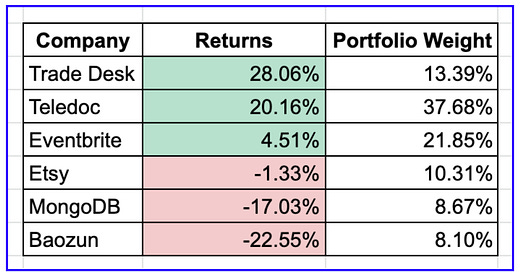Investing in Mavericks: What Returns Need To Be?
If you are finding my writing useful, please share this newsletter with one person who may also find it helpful. Thanks!
Last week, I wrote about Investing in Mavericks. I believe this approach is akin to how Venture Capitalists invest in startups. Therefore, to be successful, this approach would need to generate a similar returns profile. That is, its returns distribution needs to be similar to a good Venture Capital Portfolio. A good VC fund tends to generate the following returns:
10-20% Homeruns:
10-20% of the investments “return the fund”. These few investments make up for the mediocre performance of all other investments combined, and end up carrying the fund. In a 20 company portfolio, this would imply that at most, 2-4 companies would return the fund.
30-40% Base Hits:
30-40% of the investments “return your capital”. In a 20 company portfolio, this would imply that from 6-8 companies, on average, you would stand to get your money back, or make a small profit or loss.
30-40% Distractions:
30-40% of the investments would result in a zero!
In a 20 company portfolio, you would expect to lose your whole investment (or a meaningful amount) in the remaining 6-8 companies within the fund.
Such investments are painful, but inevitable in this type of investing. This is the price Venture Capitalists pay to be able to invest in Homeruns. I call these Distractions because these are where VCs end up spending most of their time, doing damage control and trying to help the under-performing companies they have invested in. In the case of Public Market Investing, over time such investments would become a smaller and smaller component of the portfolio, and as such, should take up less time and mental energy. However, experiencing losses is twice as difficult, psychologically, compared to experiencing gains. As a result, these Distractions could cause great psychological pain. It’s already quite apparent that Mavericks have very volatile stock prices. Let’s see how this plays out.
The Power Law
Ideally, the Homeruns create investment returns that follow a power law distribution (meaning, the best investment ends up being worth about as much as all the rest of the investments combined. And the second best investment ends up about as valuable as number three through the rest, and so on).
“If we are successful, winners (which should return multiples of their original investment) should cover the losses from all the Distractions, and then some...because the most you can lose per investment is 100%.”
Given a power law distribution, to succeed we need to do the following: First and foremost, we must seek to invest in companies with the potential to reach massive scale. Getting just a “double” isn’t good enough. We need to let our winners grow. A better model may be to invest in promising companies that we think can one day be 10X their current size. An even better approach may require us to add to our winners (just like VCs do!). A daunting task, for sure. But, by investing with this math in mind, if we are successful, winners (which should return multiples of their original investment) should cover the losses from all the Distractions, and then some...because the most you can lose per investment is 100%.
Some Portfolio Observations
It’s quite interesting that we are already starting to see this happen! Of course, this is just a coincidence since we haven’t been investing this strategy long enough to make any conclusions… With that said, based on closing prices today (Wednesday December 4 2019), here are some observations
Notice how Trade Desk (the best performing of our 6 Mavericks mentioned so far) has higher returns compared to all remaining investments. Similarly Teledoc (the second best performer) has higher returns than all remaining investments, and so on...

Over time we would like to see the best performing companies having the highest portfolio weighting. Today, that isn’t the case. Both Teledoc and Eventbrite have a bigger portfolio weighting compared to the Trade Desk.
We are also starting to see that the under-performing companies are becoming a lower weighting in the portfolio.
Once we have invested in several companies, we will see how our return distribution pans out.
You can always follow their Performance on the Scorecard here.
To follow along, Subscribe.


